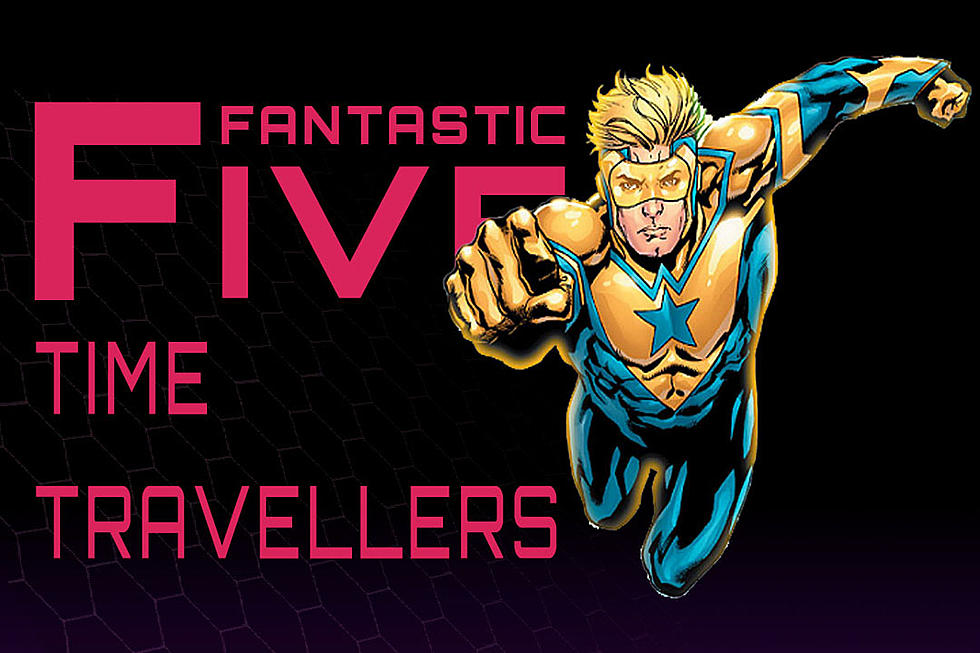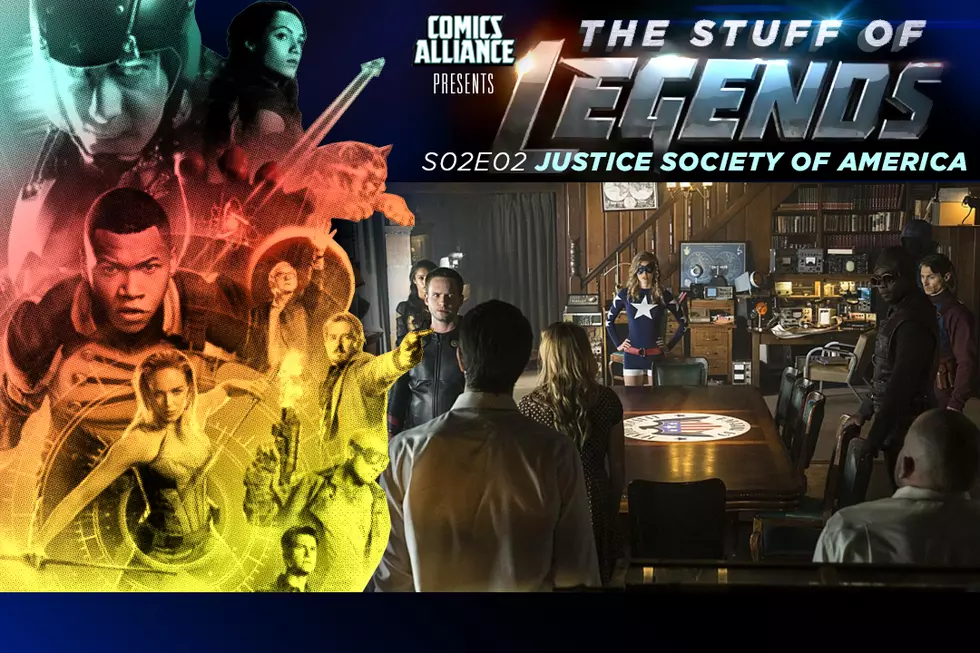
Ask Chris #255: In Defense Of Snapper Carr
Q: Why does Jimmy Olsen work so well as Superman's Pal when Snapper Carr doesn't work as the Justice League's? -- @luckyrevenant
A: I honestly hadn't considered it until I saw this question, but the more I think about it, the more I realize that you're right. Snapper Carr, the finger-snapping teenage mascot of the Justice League from back when it actually wasn't that unusual for the Justice League to have things like teenage mascots, really is the direct descendant of Jimmy Olsen --- at least from a character standpoint. They fill that same role, the kid who gets to hang out with all your favorite superheroes so that you too can imagine yourself hanging with Batman and Superman. And yet, while Jimmy ranks at #3 in my illustrious and immutable list of the greatest comic book characters of all time, Snapper is one of the most ignored and forgotten characters of the entire Silver Age.
But the thing is, it's not because he's a bad character. Snapper's actually kind of great. Just, you know, not when he hangs out with the Justice League.
The reason why Snapper didn't work as the Justice League's kid sidekick is so obvious that it's pretty much right there in the question, but you can't really blame the editors at DC for giving it a shot, especially if you're looking at him in the context of Jimmy Olsen.
I've referred to Jimmy before as the Harley Quinn of his day, since he was imported from the radio show, but it might also be a pretty accurate metaphor for his popularity, too. I mean, really, it can never be overstated how bizarre it was that there was a time in this world where Jimmy Olsen, the third most notable character in Superman's supporting cast, had his own ongoing series for well over a hundred issues, but that it actually did exist is a huge testament to how popular he was. They weren't exactly handing out solo titles for characters that they didn't have absolute faith in back in the '50s, especially since the prevailing theory --- the exact opposite of the one that we're working under today --- was that readers wouldn't trust a comic without a long history.
That line of thinking would start to fade in the early '60s for obvious reasons, but it held on for a while, and in the '50s, there was a good reason. Since readers had been burned already by the boom and bust of the Golden Age, when the market was flooded by a whole slew of new titles trying to capitalize on the new superhero genre, the idea was that a first issue or a new series was a comic that you couldn't really trust, while books like Action Comics or Batman had a proven track record of a hundred issues.
That made the editors and publishers at DC very apprehensive about launching a new series, and really, they could afford to be. Anthology titles like Showcase, Adventure Comics, Brave and the Bold, and even Action offered the best of both worlds, working as titles where publishers could try out new characters --- like, say, the Justice League of America --- before they actually committed.
But while Jimmy's first few solo adventures did appear in Action to test the waters, he got his own title in 1954 with a new #1, and like I said: That's huge. Robin didn't have his own title. Aquaman didn't have his own title. Lois wouldn't have hers for another four years. Clearly, somebody out there liked that character enough to make him a hit.
So when it came time to revive the idea of the super-team and reincarnate the Justice Society as the Justice League, it makes sense that they'd try to tack on something that would capture the success of Jimmy Olsen, too. There's even precedent for it --- The JSA had their own "mascot" type characters, in the form of Johnny Thunder, who's often seen as Snapper's counterpart when the two groups hang out with each other.
Of course, there was also Ma Hunkel, the Golden Age Red Tornado, but if we're going to be completely real with each other, she's way more of a superhero than, like, 75% of the JSA. She's worth at least two Hawkmans and four or five Golden Age Atoms, bare mins.
Anyway, that's how you get Snapper Carr, short-lived Teen Sidekick to the Justice League of America, and while I'll admit that I haven't read a whole lot of Silver Age JLA --- in all honesty and with all due respect to Gardner Fox and Mike Sekowsky, that stuff usually bores me to tears --- there's a pretty obvious problem with that setup. The Justice League, or at least that Justice League, isn't really built around having supporting characters hanging around.
The whole idea, after all, is that they're DC's most powerful characters (and Aquaman), dealing with threats that are beyond the ability of just one of them, and when something's beyond Silver Age Superman's abilities, that's a pretty serious threat. Which, when you think about it, is why so many of them are massively powerful aliens with the ability to turn the Justice League into trees.
Well, they can't all turn the JLA into trees, but you know what I mean. Some of them have Gamma Gongs.
Point being, with a story structure like that, where the focus is on superheroic action on the largest possible scale, you don't really need some kid just hanging around snapping his fingers. As Benito Cereno put it when I mentioned this to him, even if Gardner Fox had been as good at building characters as Otto Binder, Jimmy Olsen's primary architect, there just isn't a whole lot of room in a Fox story for anything that's not superheroes dividing into teams and fighting monsters.
So really, it's not a problem with Snapper as a character, it's his role in the story. You don't really want to see Alfred or Commissioner Gordon hanging around the Justice League either, you know? I mean, I do, but I've long since accepted that this is my own problem to deal with.
The thing is, once he's there, you can't really get rid of him. He's always going to be the footnote, the asterisk, because he's actually a member of the Justice League and if there's one thing that DC's really good at telling us, it's that being in the Justice League is kind of a big deal. He's tied to a very specific part of the history of that universe, and more than anything about his character, that makes him a big deal.
This, incidentally, is kind of the same problem that you got with Rick Jones over at Marvel. The last thing the Hulk needs is a guitar-strumming ham radio enthusiast cramping his style, but when he's in there as a bit part of his origin, you can't ever really get rid of him. With Rick, though, the solution was just to keep on bouncing him around the universe until something stuck, sending him to sidekick for Captains Marvel and America and eventually --- and bizarrely --- ROM Spaceknight, until the fact that he was just perpetually drifting around the fringes of the universe became a defining characteristic in its own right.
With Snapper, though, they took a very different path. In the '80s, there was briefly an attempt to revive him with super-powers and a spacefaring team of heroes that came out of Invasion!
I've mentioned that book before as being one of DC's best crossovers, ranking right behind DC One Million, but while it did a whole lot of stuff right --- coming in at three eighty-page giant issues rather than a longer maxi-series, giving a stage for some of the best crossover tie-ins ever, using existing features of the DC Universe to add something big, adaptable and interesting in the form of the Metagene --- the bold new direction for Snapper Carr was not one of them.
I suspect that might have had something to do with tethering his new super-power of teleportation to his existing gimmick of snapping his fingers.
But here's the thing: Unlike Jimmy Olsen, who never quite got another shot at being great once the DC Universe made its big change in '87 and the Superman franchise moved away from the kind of storytelling that allowed him to have a pal who was prone to hijinx, Snapper's status as a perpetual third-stringer who never quite worked out is actually the thing that ended up making him a really great character.
It happened in the pages of Tom Peyer and Rags Morales's Hourman, which, at 25 issues, would seem woefully short-lived if it didn't also feel like it was the perfect length for that series. That's where Snapper Carr really made his return. It's as much his book as Hourman's, really, and #16, where Peyer and Morales re-tell the story of Snapper accidentally betraying the Justice League to the Joker, is one of the single best updates of a Silver Age story ever printed.
But aside from Snapper's amazing collection of t-shirts --- they were all based on slightly obscure superhero logos --- what really made him work as a character was that he was built around the idea of legacy. Time and time again I've written about how that was the driving force of the post-Crisis, pre-Flashpoint DC universe, but it's true, and it made perfect sense for Snapper to embody that idea. It's that same thing that you get from our discussion of issue numbers earlier --- they'd established that these were heroes who had been around for a while and had been a very important force in the world, and part of that meant that acknowledging that there were things that changed over the years.
And that's what makes the more modern version of Snapper so appealing. Wally West might be legacy incarnate, but in Hourman, Snapper finally became the character readers could identify with that he was originally intended to be. He was a fan at heart, someone who had loved superheroes with a passion back when he was a kid, but who lost that personal connection somewhere along the way and had resigned himself to the fact that while he was still going to keep up with them, things were never going to be as good as he remembered --- until he found that connection with a superhero that nobody else was reading about.
Or maybe that's just taking the metaphor a little too far.
Either way, it was an amazing rehabilitation of the character, one that played as an update that made sense without dismissing anything that had been there to like about him in the first place. So while Snapper Carr might not have worked as a sidekick for the Justice League, he eventually worked because of that in a way that very few other characters would've had the history to pull off.
Ask Chris art by Erica Henderson. If you’ve got a question you’d like to see Chris tackle in a future column, just send it to @theisb on Twitter with the hashtag #AskChris.
More From ComicsAlliance








![Steve Orlando And Ivan Reis Assemble New ‘Justice League of America’ Line-Up [NYCC 2016]](http://townsquare.media/site/622/files/2016/10/JLA.jpg?w=980&q=75)
